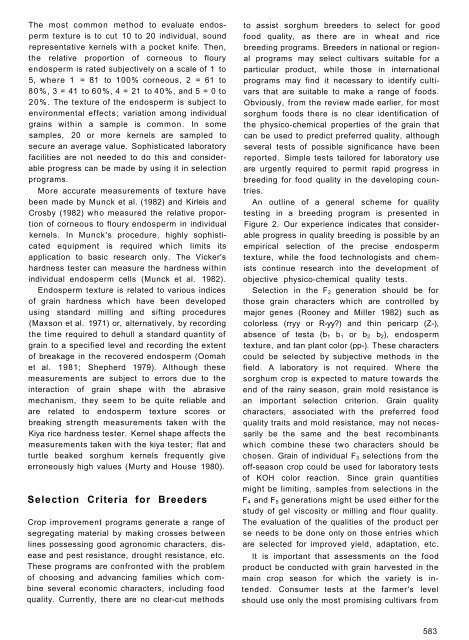RA 00048.pdf - OAR@ICRISAT
RA 00048.pdf - OAR@ICRISAT
RA 00048.pdf - OAR@ICRISAT
You also want an ePaper? Increase the reach of your titles
YUMPU automatically turns print PDFs into web optimized ePapers that Google loves.
The most common method to evaluate endosperm<br />
texture is to cut 10 to 20 individual, sound<br />
representative kernels with a pocket knife. Then,<br />
the relative proportion of corneous to floury<br />
endosperm is rated subjectively on a scale of 1 to<br />
5, where 1 = 81 to 100% corneous, 2 = 61 to<br />
80%, 3 = 41 to 60%, 4 = 21 to 40%, and 5 = 0 to<br />
20%. The texture of the endosperm is subject to<br />
environmental effects; variation among individual<br />
grains within a sample is common. In some<br />
samples, 20 or more kernels are sampled to<br />
secure an average value. Sophisticated laboratory<br />
facilities are not needed to do this and considerable<br />
progress can be made by using it in selection<br />
programs.<br />
More accurate measurements of texture have<br />
been made by Munck et al. (1982) and Kirleis and<br />
Crosby (1982) who measured the relative proportion<br />
of corneous to floury endosperm in individual<br />
kernels. In Munck's procedure, highly sophisticated<br />
equipment is required which limits its<br />
application to basic research only. The Vicker's<br />
hardness tester can measure the hardness within<br />
individual endosperm cells (Munck et al. 1982).<br />
Endosperm texture is related to various indices<br />
of grain hardness which have been developed<br />
using standard milling and sifting procedures<br />
(Maxson et al. 1971) or, alternatively, by recording<br />
the time required to dehull a standard quantity of<br />
grain to a specified level and recording the extent<br />
of breakage in the recovered endosperm (Oomah<br />
et al. 1981; Shepherd 1979). Although these<br />
measurements are subject to errors due to the<br />
interaction of grain shape with the abrasive<br />
mechanism, they seem to be quite reliable and<br />
are related to endosperm texture scores or<br />
breaking strength measurements taken with the<br />
Kiya rice hardness tester. Kernel shape affects the<br />
measurements taken with the kiya tester; flat and<br />
turtle beaked sorghum kernels frequently give<br />
erroneously high values (Murty and House 1980).<br />
Selection Criteria for Breeders<br />
Crop improvement programs generate a range of<br />
segregating material by making crosses between<br />
lines possessing good agronomic characters, disease<br />
and pest resistance, drought resistance, etc.<br />
These programs are confronted with the problem<br />
of choosing and advancing families which combine<br />
several economic characters, including food<br />
quality. Currently, there are no clear-cut methods<br />
to assist sorghum breeders to select for good<br />
food quality, as there are in wheat and rice<br />
breeding programs. Breeders in national or regional<br />
programs may select cultivars suitable for a<br />
particular product, while those in international<br />
programs may find it necessary to identify cultivars<br />
that are suitable to make a range of foods.<br />
Obviously, from the review made earlier, for most<br />
sorghum foods there is no clear identification of<br />
the physico-chemical properties of the grain that<br />
can be used to predict preferred quality, although<br />
several tests of possible significance have been<br />
reported. Simple tests tailored for laboratory use<br />
are urgently required to permit rapid progress in<br />
breeding for food quality in the developing countries.<br />
An outline of a general scheme for quality<br />
testing in a breeding program is presented in<br />
Figure 2. Our experience indicates that considerable<br />
progress in quality breeding is possible by an<br />
empirical selection of the precise endosperm<br />
texture, while the food technologists and chemists<br />
continue research into the development of<br />
objective physico-chemical quality tests.<br />
Selection in the F 2 generation should be for<br />
those grain characters which are controlled by<br />
major genes (Rooney and Miller 1982) such as<br />
colorless (rryy or R-yy?) and thin pericarp (Z-),<br />
absence of testa (b 1 b 1 or b 2 b 2 ), endosperm<br />
texture, and tan plant color (pp-). These characters<br />
could be selected by subjective methods in the<br />
field. A laboratory is not required. Where the<br />
sorghum crop is expected to mature towards the<br />
end of the rainy season, grain mold resistance is<br />
an important selection criterion. Grain quality<br />
characters, associated with the preferred food<br />
quality traits and mold resistance, may not necessarily<br />
be the same and the best recombinants<br />
which combine these two characters should be<br />
chosen. Grain of individual F 3 selections from the<br />
off-season crop could be used for laboratory tests<br />
of KOH color reaction. Since grain quantities<br />
might be limiting, samples from selections in the<br />
F 4 and F 5 generations might be used either for the<br />
study of gel viscosity or milling and flour quality.<br />
The evaluation of the qualities of the product per<br />
se needs to be done only on those entries which<br />
are selected for improved yield, adaptation, etc.<br />
It is important that assessments on the food<br />
product be conducted with grain harvested in the<br />
main crop season for which the variety is intended.<br />
Consumer tests at the farmer's level<br />
should use only the most promising cultivars from<br />
583

















